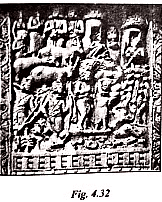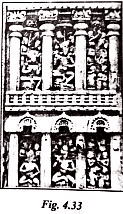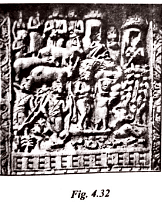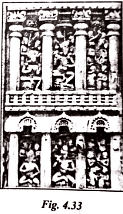Q1: Were the ideas of the Upanishadic thinkers different from those of the fatalists and materialists ? Give reasons for your answers.
Ans: The ideas of the Upanishadic thinkers is not much different from those of the fatalists and materialists. This is brought out by the following arguments.
(i) The essence of the philosophy of Jainism was already in existence in India, even before the birth of Lord Mahavir and Vardhaman.
(ii) Ahimsa or non-violence is the most important principle of Jainism. But this also form the basic thought of Hindu religion. Thus, there is a lot of similarity between the both the streams of the religion.
(iii) Upanishada believes and teaches Karma Theory. It means men and women should act and not worry about getting rewards. Fatalists also believed in the idea of work without thinking of the consequences. Thus there is a lot of similarity between the two.
(iv) Both fatalists and materislists believe that human beings are made , of four elements, earth, water, sky, air and fire.
Thus, we are inclined to agree that the idea of the Upanishad thinkers Eire not much different from that of the fatalists and materialists.
Q2: Summarise the central teachings of Jainism.
Ans: The main teachings of Jainism are as follows:
(i) The entire world is animated. Life exists even in rocks and stones normally considered non-living.
(ii) The principle of non-violence is practised in extreme form in Jainism. No harms should be caused to animals, plants and insects and any other living beings that may include rocks and stones too. This is notable that Jains are forbidden to eat late night lest they kill insects by mistake.
(iii) The cycle of birth and rebirth is shaped through Karma. If one is to escape this cycle of Karma, one must practise ascetism and penance. It is possible when one renounces the world. So one has to live in monastery to attain salvation.
(iv) Jain monks have to take vows to observe the following:
(a) Not to kill anyone
(b) Not to steal anything
(c) Not tell lies
(d) Not to possess property
(e) To observe celibacy.
Q3: Discuss the role of the begums of Bhopal in preserving the stupa at Sanchi.
Ans: Begums of Bhopal made a great contribution to the preservation of the Stupa of Sanchi. Following are the major contribution made by them.
(i) Shahejahan Begum and her successor Sultan Jahan Begum of Bhopal were the rulers of Bhopal, who made generous grants to the preservation of the Stupa of Sanchi.
(ii) A museum was built near the stupa and it was built mainly on the financial support of Begum Sultan Jahan Begum.
(iii) The support to preserve the stupa came from the Europeans also.
(iv) French and British both took the plaster cast copies of the pillars of the stupas to be displayed in the museums at France and Britain. They also contributed financially to preserve the stupa.
Q4: Read this short inscription and answer:
In the year 33 of the maharaja Huvishka, (a Kushana ruler), in the first month of the hot season on the eighth day, a Bodhisatta was set up at Madhuvanaka by the bhikkhuni Dhanavati, the sister’s daughter of the bhikkhuni Buddhamita, who knows the Tipitaka, the female pupil of the bhikkhu Bala, who knows the Tipitaka, together with her father and mother.
(i) How did Dhanavati date her inscription?
(ii) Why do you think she installed an image of the Bodhisatta?
(iii) Who were the relatives she mentioned?
(iv) What Buddhist text did she know?
(v) From whom dicTshe learn this text?
Ans:
(i) Dhanavati dated her inscription that she placed the inscription at Madhuvanaka in the first month of the hot season on the eighth day in the year 33 of the Maharaja named Havishka.
(ii) I think that she (the Bhikkhuni Dhanvati installed an image of the Bodhisatta to show that Mahayana sect of Budhhism was becoming popular day by day and Boddhisattas were considered great personalities in Buddhism during the reign of the Kushana rulers.
(iii) She has mentioned her own mother’s sister’s name Buddhamita. The lady was a Bhikkuni. She had also mentioned Bhikkuni Bala and her parents.
(iv) She knew the Tipitaka.
(v) She learnt the text from the Bhikkhuni Buddhamita who was the female pupil of the Bala.
Q5: Why do you think women and men joined the sangha?
Ans: The important reasons why men and women joined sanghas could be as follows:
(i) Many of them wanted to renounce the worldly pleasures.
(ii) They could study the Buddhist literature and philosophy by staying in the company of other monks.
(iii) Many people entered sanghas to become priests and teachers of Buddhism.
(iv) All were considered equal and the previous social identity was to be renounced.
(v) The environment of sanghas was democratic. The decision making within sanghas was based on voting. This attracted many and they took to the life of sanghas
Q6: To what extent does knowledge of Buddhist literature help in understanding the sculpture at Sanchi?
Ans: Buddhist literature help us upto some extent in understanding the sculpture at Sanchi. It is important that the sculptures at Sanchi depict the teachings of Buddha only. The teachings of Buddha are captured in the literature.
It is notable that Buddha used to roam around among people , preaching them on his teachings. However, he did not claim supernatural power. He told us that the world is ever changing. It is full of sorrows. Sorrow flows out of desire. Buddha asked the followers to take the middle path, not too much of penance, nor too much of indulgence. The literature of Buddhism is useful for the interpretation of the sculpture at Sanchi. People are shown in different moods and in sorrow. Different stages of life are depicted and so on. Hence, it can be stated that Buddhist literature throws valuable light on the sculptures of the Sanchi.
Q7: Figs. 4.32 and 4.33 are two scenes from Sanchi. Describe what you see in each of them, focusing on the architecture, plants and animals, and the activities. Identify which one shows a rural scene and which an urban scene, giving reasons for your answer.

 Ans: In both the figure we see depiction of a way of life. In figure 4.32 we see more depiction of animals and plants. The depiction of how houses are built in this figure are very rural in the depiction. Houses looks as if they are built of mud and the roof are made of thatch. The way they are drressed one can deduce that they are farmer or they are hunter. There is also a depiction of a man with a bow. he could be a hunter.
Ans: In both the figure we see depiction of a way of life. In figure 4.32 we see more depiction of animals and plants. The depiction of how houses are built in this figure are very rural in the depiction. Houses looks as if they are built of mud and the roof are made of thatch. The way they are drressed one can deduce that they are farmer or they are hunter. There is also a depiction of a man with a bow. he could be a hunter.
In figure 4.33 we see a very different depiction, with architecture that looks that of a town. The pillar and the person depicted inside seems to be of high status as there is someone carrying an umbrella on top of him. The sculpture also shows as if the depiction is of a palace ad its way of life. We are able to see some people in their activities.
from the above analysis we can safely presume tha the figure 4.32 depicts rural way of life whereas figure 4.33 depicts urban way of life.
Q8: Discuss the development in sculpture and architecture associated with the rise of Vaishnavism and Shaivism.
Ans: Vaishnavism and Shaivism are the two branches of Hinduism. In case of Vaishnavism, Lord Vishnu was regarded as the chief deity. In case of Shaivism Lord Shiva was regarded as the chief deity. Both traditions were part of the Bhakti movement. Bhakti movement emphasised on the love and devotion of the devotee to : the God.
This tradition of Vaishnavism and Shaivism also impacted the tradition of architecture and sculpture. The temples developed the house deities. The initial temples were small and simple. It was a small room called Garbhagriha. Later it expanded, a tall structure was built on the garbhagriha. It was called Shikhara. The walls of the temple were decorated with suitors. Soon temples were built that had huge entrance and big halls for the comfort of visitors.
Many of these temples were carved out of rocks. These artificial caves were turned into temples. The tradition of article caves is old who had renounced the world. The most important were the Ajivikas, that developed as a sect during the reign of Asoka. Later a good example of the rock-cut temple is the Kailash Nath temple of the 8th Century. It was carved out of a single piece rock. There is a copper plate inscription at the temple of Ellora wherein the sculptor exclaims, “How did I make it!” Sculpture was yet another way of expression. Deities were given many shapes and forms in the sculpture. Shiva has been shown in the form of Linga. Many deities have shown in different forms, sometimes grotesque. There were also combination of man and animal forms.
Q9: Discuss how and why stupas were built.

 Ans: About 200 years after the time of Buddha King Asoka erected a pillar at Lumbini. This was to announce the visit of Buddha to this place.Stupas were the mounds put on the bodily remains of the body of Lord Buddha or of any object that was used by him. At the place of stupas such objects were buried. These were places of great respect under the tradition of Buddhism, as they had the relics of Buddha. As per the description of Asokavadana winch a famous Buddhist book, Emperor Asoka gave Buddha’s relic to all major cities. Later on such places stupas were put. The most important stupas are at Sanchi, Bharhut and Saranath.
Ans: About 200 years after the time of Buddha King Asoka erected a pillar at Lumbini. This was to announce the visit of Buddha to this place.Stupas were the mounds put on the bodily remains of the body of Lord Buddha or of any object that was used by him. At the place of stupas such objects were buried. These were places of great respect under the tradition of Buddhism, as they had the relics of Buddha. As per the description of Asokavadana winch a famous Buddhist book, Emperor Asoka gave Buddha’s relic to all major cities. Later on such places stupas were put. The most important stupas are at Sanchi, Bharhut and Saranath.
The structure of a stupa was like a dome and hemisphere. On the top of it, there would be a balcony called harmik. This balcony represented the abode of God. The harmik was covered with an umbrella. There used to be railings around the balcony.
The construction of the stupas was made possible by the contribution of many. On the forefront were the monarchs. The Satvahan Kings offered huge amount for the construction of the stupqs. Apart from the monarchs, merchants, artisans and common men and women also contributed to the construction of the stupas.
Q10: On an outline world map, mark the areas to which Buddhism spread. Trace the land and sea routes from the subcontinent to these areas.
Ans:
(i) India,
(ii) Bhutan,
(iii) Afghanistan,
(iv) China,
(v) Japan,
(vi) Korea,
(vii) Thailand,
(viii) Sri Lanka,
(ix) Myanmar,
(x) Indonesia,

Q11: Of the religious traditions discussed in this chapter, is there any that is practised in your neighbourhood? What are the religious texts used today, an how are they preserved and transmitted? Are images used in worship? If so, are these similar to or different from those described in this chapter? Describe the buildings used for religious : activities today, comparing them with early stupas and temples.
Ans: The chapter discuss the religious traditions of ancient India which included, Hinduism, Jainism, Buddhism, so on. As I live in the walled city of Delhi have seen people practising all these traditions.
The religious textbooks of all religions are preserved and kept with great respect. They have been translated in many languages including many regional languages of the country. Now they are also preserved in the form of CD and other modern devices. Images are also used by worshippers of these religions. The Hindus deities have almost same images as they had in the past. Jains and Buddhists also use images.Temples are used by hindus, buddhists and jams. Mosques are made by muslims and churches by the Christians. The structure of all these are different but with some similarities too.

 Ans: In both the figure we see depiction of a way of life. In figure 4.32 we see more depiction of animals and plants. The depiction of how houses are built in this figure are very rural in the depiction. Houses looks as if they are built of mud and the roof are made of thatch. The way they are drressed one can deduce that they are farmer or they are hunter. There is also a depiction of a man with a bow. he could be a hunter.
Ans: In both the figure we see depiction of a way of life. In figure 4.32 we see more depiction of animals and plants. The depiction of how houses are built in this figure are very rural in the depiction. Houses looks as if they are built of mud and the roof are made of thatch. The way they are drressed one can deduce that they are farmer or they are hunter. There is also a depiction of a man with a bow. he could be a hunter.
 Ans: About 200 years after the time of Buddha King Asoka erected a pillar at Lumbini. This was to announce the visit of Buddha to this place.Stupas were the mounds put on the bodily remains of the body of Lord Buddha or of any object that was used by him. At the place of stupas such objects were buried. These were places of great respect under the tradition of Buddhism, as they had the relics of Buddha. As per the description of Asokavadana winch a famous Buddhist book, Emperor Asoka gave Buddha’s relic to all major cities. Later on such places stupas were put. The most important stupas are at Sanchi, Bharhut and Saranath.
Ans: About 200 years after the time of Buddha King Asoka erected a pillar at Lumbini. This was to announce the visit of Buddha to this place.Stupas were the mounds put on the bodily remains of the body of Lord Buddha or of any object that was used by him. At the place of stupas such objects were buried. These were places of great respect under the tradition of Buddhism, as they had the relics of Buddha. As per the description of Asokavadana winch a famous Buddhist book, Emperor Asoka gave Buddha’s relic to all major cities. Later on such places stupas were put. The most important stupas are at Sanchi, Bharhut and Saranath.



























